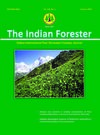Growth and Yield Attributes of Melia composita and Emblica officinalis Based Agri-Silvi-Medicinal Agroforestry in Degraded Lands
DOI:
https://doi.org/10.36808/if/2018/v144i1/121310Keywords:
Growth, Melia composita, Emblica officinalis, Medicinal Plants, Agri-Silvi-Medicinal Agroforestry.Abstract
An experiment of Melia composita and Emblica officinalis in combination with medicinal plants i.e. Rauvolfia serpentina and Withania somnifera was conducted in degraded lands at Naukragrant, Haridwar (Uttarakhand) and Handesra, Mohali (Punjab). The geometry of M. composita and E.officinalis in RBD at 6m x 4m with R. serpentina and W. somnifera as intercrop spacing (60x60cm) tree to crop line along with seasonal agriculture crops like Masoor and Groundnut was kept.
The growth performance of trees and soil status were observed. Initially, soil was found slightly alkaline with pH values (8.20 and 8.18) at sites Naukragrant and Handesra respectively. The average soil pH was found neutral (7.71) at site Naukragrant and slightly alkaline (7.82) value showed at site Handesra after four years of plantation. The Organic Carbon, available nutrients (Nitrogen and Phosphorus) values indicates increases at both sites and highest values found at site Naukragrant as compared to site Handesra.
Initially growth of E. officinalis performed better in respect of height at site Handesra and similarly M. composita performed better height at site Naukragrant respectively. It is also observed that E. officinalis (3.06 mt. and 27.44cm) with agriculture crops at site Naukragrant (Haridwar) and M. composita (9.38 mt. and 41.78cm) without crops at site Handesra (Mohali) performed better in respect of maximum height and girth in degraded land after 3 years plantation respectively.
The fresh yield of R. serpentina (135.30 q/ha at 90% survival) under Aonla and W. somnifera (41.57 q/ha at 50% survival) under Melia also performed maximum at site Handesra (Punjab). Similarly Masoor (8.0 q/ha) and Groundnut (13.75 q/ha) performed well under Aonla at site Naukragrant (Haridwar). M. composita and E. officinalis based agrisilvi- medicinal agroforestry have proved to be the most successful as it thrives best in adverse agro-climatic conditions as well as degraded lands.
References
Bhadauria S. (2005). Chemistry and cultivation technology of Emblica officinalis- An alternative land use for alternative land use for alkali wasteland. Recent Advances in Medicinal Plant Research: Vision 21st Century, (Editors: S.K. Prabhuji, G.P. Rao and S.K. Patil) Satish Publication House, New Delhi, Pp. 159-170.
Dutt V. and Thakur P.S. (2004). Bio-economics of cropping systems combining medicinal and aromatic herbs with commercial timber tree species. Ind. J. Agrofor., 6: 1-7
Gill A.S and Gupta S.K. (2007). Evaluation of trees for biomass production under agroforestry system in rainfed semi-arid subtropics. Indian J. Trop. Biodiv., 15(2): 155-159.
Giller K.E. (2001). Nitrogen fixation in tropical cropping systems. 2nd edition, Cabi Series, CABI Publishing series, Wallingford, U.K. 222-250 pp.
Jackson M.L. (1973). Soil Chemical Analysis. Prentice Hall of India Ltd., New Delhi.
Piper C.S. (1950). Soil and Plant Analysis. Adelaide University Press, Adelaide, Australia.
Puri S. and Nair P.K.R. (2004). Agroforestry research for development in India: 25 years of experience of a national programme. Agroforestry Systems, 61:437-452.
Ram Newaj, Shukla S.K. and Yadav R.S. (1998-99). Varietal evaluation of aonla (Emblica officinalis) in agrisilvihorticultural system under rainfed conditions on marginal lands. Annual Report, NRCAF, Jhansi, pp.44-46.
Singh G., Singh H., Dagar T.C., Singh N.T. and Sharma V.P. (1977b). Evaluation of agriculture, forestry and agroforestry practices in terms of productivity, sustainability and economics in moderately alkali soil. Agroforestry Systems, 37: 279-295.
Singh A.K., Saggar S. and Banerjee S.K. (2001). Fertilizer response to growth of Dalbergia sissoo. Roxb. in a highly degraded land. Indian J. Tropical Biodiversity, 9: 42-49.
Downloads
Downloads
Published
How to Cite
Issue
Section
License
Unless otherwise stated, copyright or similar rights in all materials presented on the site, including graphical images, are owned by Indian Forester.





